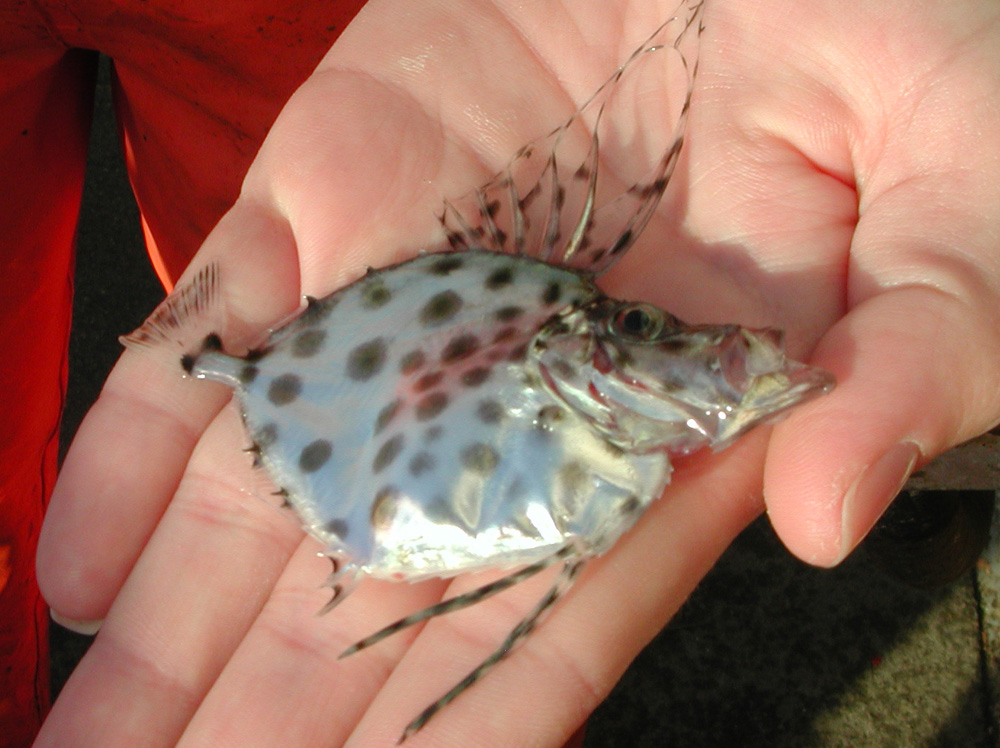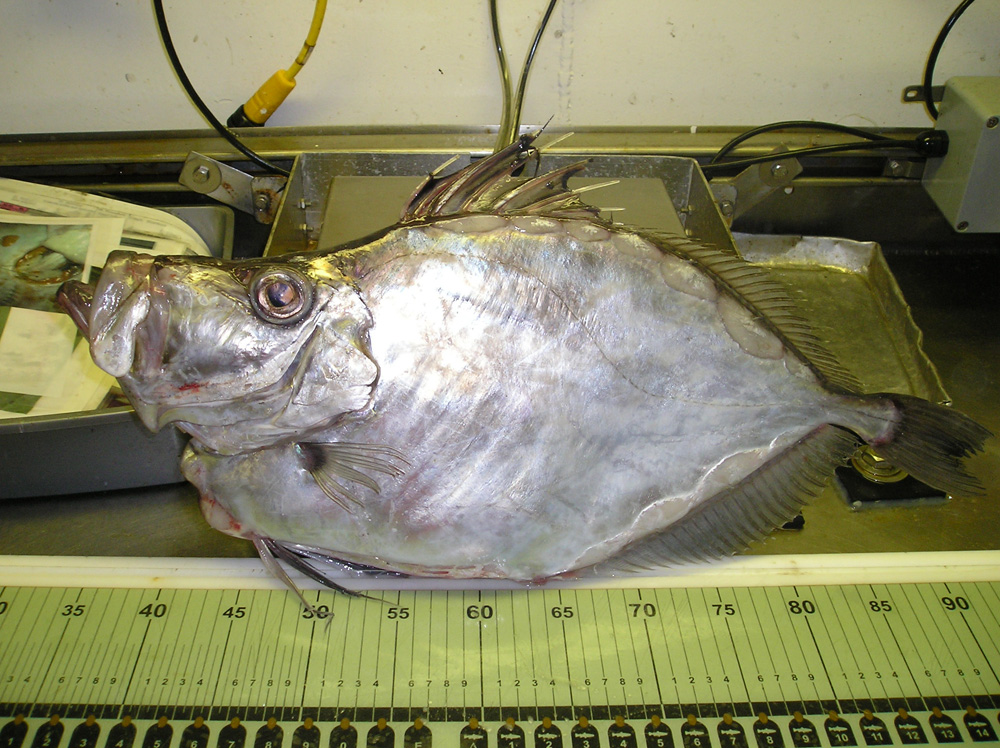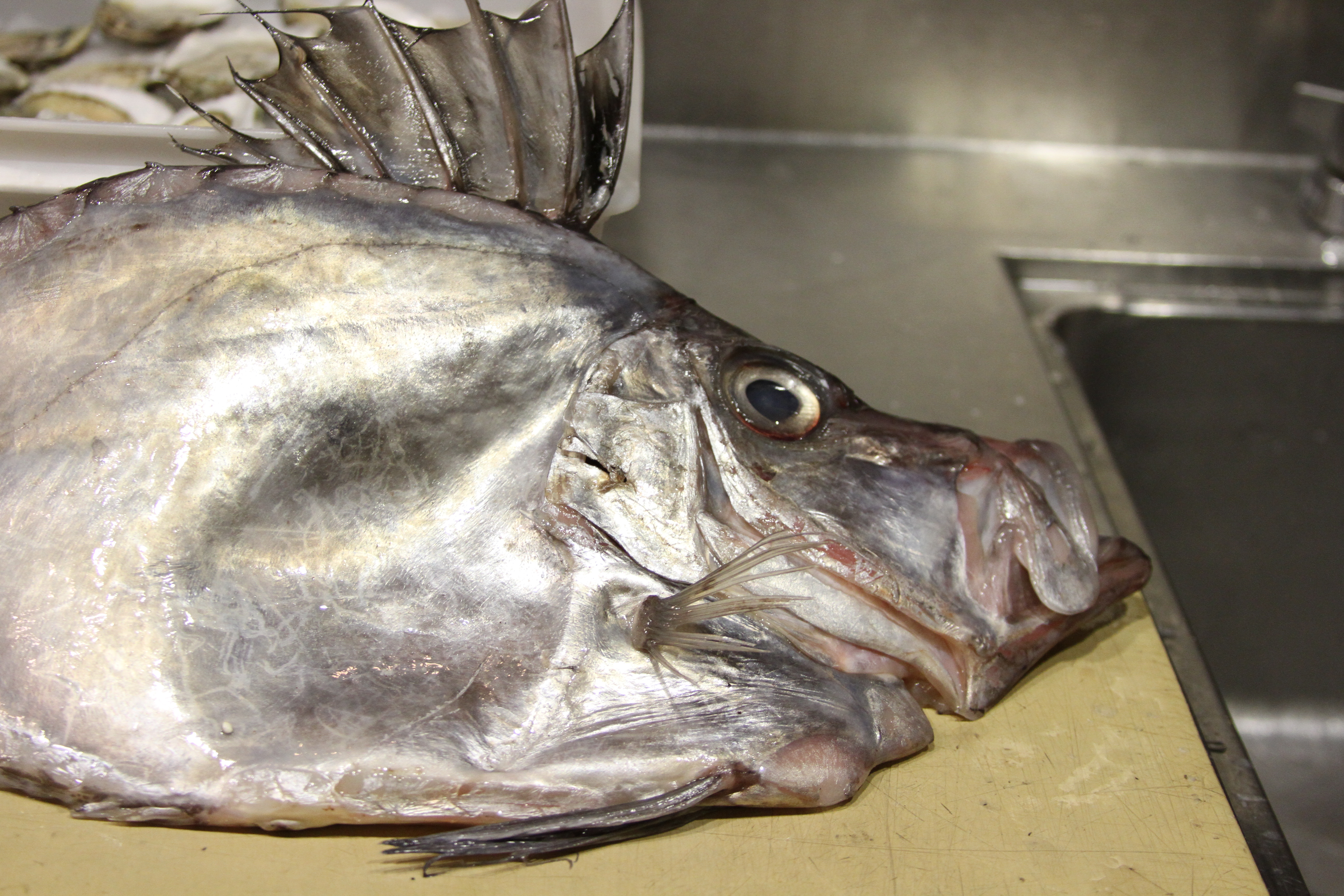
Zenopsis conchifer
FAMILY
Zeidae
TAXONOMY
Zeus conchifer Lowe, 1852, Madeira.
OTHER COMMON NAMES
English: Mirror dory (Australia), sailfin dory, silvery John
Dory; Portuguese: Peixe galo, falo branco.
PHYSICAL CHARACTERISTICS
Attains a total length (including the tail fin) of 2 ft, 8 in (80
cm) and a weight of 9 lb (4 kg). The head and body are very
compressed and shaped like an oblong disc, or dinner platter.
The dorsal head profile is slightly concave. Dorsal fin spines of
the adult are elongated and filamentous. The body has no
scales. There is a row of five to eight bony bucklers, each with
a strong spine, along each side of the bases of the anal and
both dorsal fins. There are two or three bucklers on the isthmus
and ventral midline of the chest in front of the pelvic fins
and seven or eight pairs of bucklers (ridged bony scutes) along
the ventral midline of the abdomen, from the base of the pelvic
fins to the first anal fin spine. The thoracic region is compressed.
The pelvic fins are large and close together, inserted
on the chest below the eyes and well in front of the pectoral
fins. Each has six or seven soft rays. The first pelvic ray could
be considered a spine, because it is unbranched and not segmented,
but (unlike the pelvic fin spine of Zeus ) it is a biserial
(double) ray. There are five to eight bony bucklers (enlarged,
platelike scales) along the base of the soft dorsal and anal fins
and seven to 10 pairs of spiny scutes along the belly, from the
base of the pelvic fins to the anus. The dorsal fin has nine to
10 spines and 24–27 rays; the anal fin has three spines (the first
two movable and the third fixed) and 24–26 rays. The caudal
fin has 11 branched rays; the pectoral fins are much smaller
than the pelvic fins, with 12 or 13 rays. Dorsal, anal, and pectoral
fin rays are unbranched. Adults are silvery with a faint,
dusky mid-lateral spot above the pectoral fin and below the lateral
line. Small juveniles, 1–4 in (2–10 cm) long, are covered
with scattered small black spots.
DISTRIBUTION
Mainly continental. Western Atlantic from Canada to Argentina,
including the Gulf of Mexico and Caribbean Sea, and eastern
Atlantic from France and British Isles to South Africa. Also in
the Indian Ocean from South Africa to Kenya and India.
HABITAT
Adults are found over soft (sandy or muddy) or hard (rocky)
substrata. They are demersal, usually caught near the bottom
of the continental shelf or upper continental slope region at
depths of 33–1,188 ft (10–360 m). Occasionally found in midwater
well above the bottom.
BEHAVIOR
The
BEHAVIOR
of the buckler dory is poorly known, as this
species is rarely observed in shallow water. Adults usually are
found in aggregations near the bottom. A slow, stalking, ambush-
predator mode of hunting is assumed, and the greatly
protrusible upper jaw compensates for the feeble swimming
musculature.
FEEDING ECOLOGY AND DIET
Feeds on demersal fishes, crustaceans, and cephalopods and often
makes excursions above the bottom to feed on midwater
fishes. Prey species selection is influenced by availability and
accessibility. The dominant species in the diet is likely to be
the most abundant prey in the
HABITAT
. Adult buckler dory have
few predators other than great white sharks and goosefish
(Lophius spp.). Juveniles are likely prey for most piscivorous
predators.
REPRODUCTIVE BIOLOGY
Reproduction is similar to that of the John dory (see following
account).
CONSERVATION STATUS
Not listed by IUCN. The species is taken as bycatch in various
trawl fisheries in the North Atlantic, off southern Brazil,
Namibia, and South Africa. There are no fishing regulations or
catch data that apply specifically to the buckler dory.
SIGNIFICANCE TO HUMANS
None known.
Photo Gallery of - Buckler dory





 Animalia Life
Animalia Life